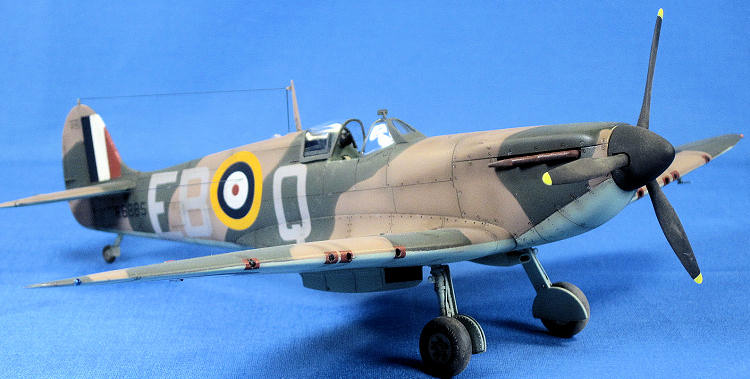
Tamiya 1/48 Spitfire I
| KIT #: | 61032 |
| PRICE: | $30.00 or so |
| DECALS: | Three options |
| REVIEWER: | Scott Lyle |
| NOTES: |
Aviaeology #A0D48C04,
RAF & FAA
Aircraft Serials – 4” & 6” Night (Black) |

| HISTORY |
Occasionally
I get asked why I’m interested in scale modeling and my usual fumbling response
is that I like working with my hands and building replicas of things I’m
interested in, which tend to be things of war.
Over the years I’ve pondered the next logical question - “Why are you
interested in things of war?”
And
to that I still have no answer, only guesses.
Who can explain why you’re interested in the things you’re interested in?
An interest in things of war and military affairs in general could be
stoked I suppose by the basic human drama of it all.
One nation pits its citizens, technology, and might against that of
another, and the winner not only gets the spoils but also gets to write history.
For the citizens of the winning nation life generally goes on, but for
those of the losing nation life is completely altered.
This proposition was never more apparent than during the s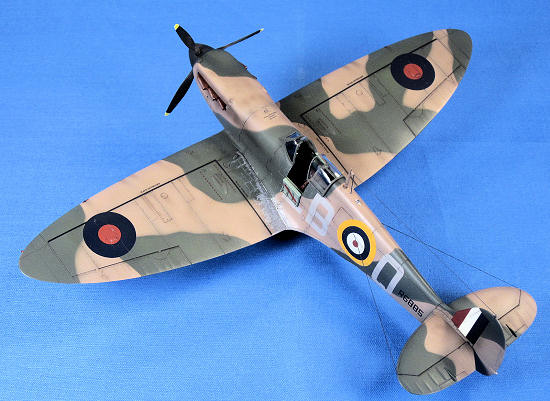 ummer of 1940
when Hitler’s armies sat on the coast of
ummer of 1940
when Hitler’s armies sat on the coast of
The drama of a huge land battle is self-apparent, but what made the
The Hurricane and Spitfire will always be the heroes of the battle, with
the more numerous but less glamorous Hurricane playing second fiddle.
Over the years the Spitfire has become a beloved legend, always a
contender for the title of greatest fighter aircraft ever built.
In production throughout the entire war
and highly successful wherever it fought, it goes without saying that it
deserves every accolade it has ever received.
A couple of years ago I kit-bashed a Mk. IX in 1/48 scale using the
Hasegawa kit, the Aeroclub conversion set, and a whole lot of resin extras.
Recently however the
| CONSTRUCTION |
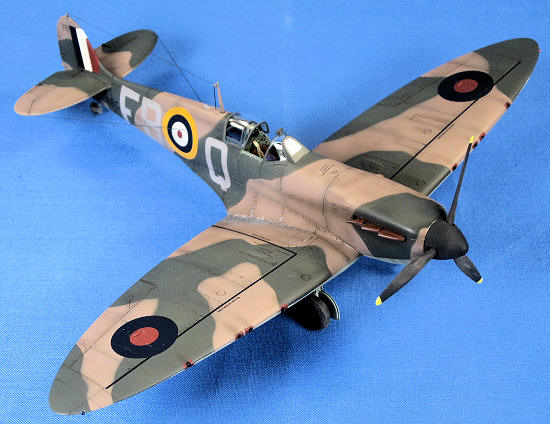 I’m
a fan of Eduard’s “Zoom” photo etch sets, and so I purchased one for this build.
The set provides just the right amount of photo etch details without
going overboard, basically giving you a color-printed instrument panel, the
seatbelts and some other small details.
Per usual construction started in the cockpit, so I had to be aware of
how to integrate the Eduard details with the kit parts.
I painted the cockpit floor, side walls, lower instrument panel, and seat
structure Testors Acrylic RAF Interior Green.
The seat was then painted
I’m
a fan of Eduard’s “Zoom” photo etch sets, and so I purchased one for this build.
The set provides just the right amount of photo etch details without
going overboard, basically giving you a color-printed instrument panel, the
seatbelts and some other small details.
Per usual construction started in the cockpit, so I had to be aware of
how to integrate the Eduard details with the kit parts.
I painted the cockpit floor, side walls, lower instrument panel, and seat
structure Testors Acrylic RAF Interior Green.
The seat was then painted
I cut the port side cockpit door from the port side fuselage half (Tamiya
provides an actual door part in the kit so you can toss the one you cut out) so
a bit more of the cockpit will be visible after assembly, and then glued the
fuselage halves together.
The
completed cockpit assembly then slides into the fuselage from underneath.
I had to fiddle with it a little to get the instrument panel and seat
bulkhead to sit properly on the ribs in the fuselage, but overall the fit was
very good.
I then sanded the seams
of the fuselage halves, a process that only took a few moments.
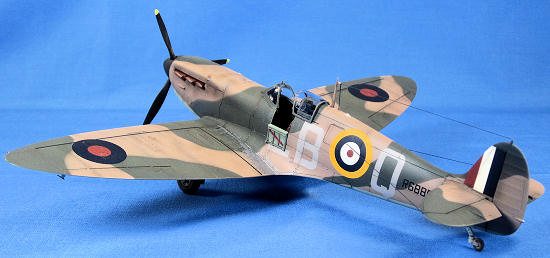 At this point the instructions would have you continue adding more detail
to the fuselage, but I deviated from that and assembled the wings next.
The upper halves were attached to the one-piece lower half, and once
again the fit was very good.
Once
the wings were dry I glued them and the horizontal stabilizers to the fuselage.
A bit of gap was present at the wing roots, but a small bead of CA glue
took care of that problem.
At this point the instructions would have you continue adding more detail
to the fuselage, but I deviated from that and assembled the wings next.
The upper halves were attached to the one-piece lower half, and once
again the fit was very good.
Once
the wings were dry I glued them and the horizontal stabilizers to the fuselage.
A bit of gap was present at the wing roots, but a small bead of CA glue
took care of that problem.
A few more items needed to be added before painting could begin.
The various coolers under the wings were glued on, as was the lower part
of the engine cowling.
I then
attached the windscreen, masked it and the cockpit opening off, and headed for
the spray booth.
| COLORS & MARKINGS |
After
a primer coat of Tamiya Surface Primer was sprayed on the model, I pre-shaded
the panel lines with some Tamiya XF-69 NATO Black.
I airbrushed Tamiya XF-21 Sky onto the undersides, letting the
pre-shading show through.
I then
masked off those areas that might be affected by spraying the upper surfaces and
sprayed a 50/50 mix of Tamiya XF-54 Flat Earth and XF-5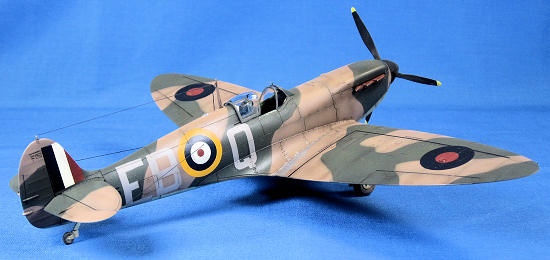 7 Buff onto said upper
surfaces.
I then used Silly Putty
to mask that color off in a Type A, hard-edged scheme (Tamiya provides a Type B
schematic printed to scale – to use for a Type A scheme you just reverse it on
the model), and sprayed Testors RAF Dark Green on to the model.
Once everything was dry I sprayed Future onto the whole model in
preparation for the decals.
7 Buff onto said upper
surfaces.
I then used Silly Putty
to mask that color off in a Type A, hard-edged scheme (Tamiya provides a Type B
schematic printed to scale – to use for a Type A scheme you just reverse it on
the model), and sprayed Testors RAF Dark Green on to the model.
Once everything was dry I sprayed Future onto the whole model in
preparation for the decals.
I used the kit’s decals for the stencils, fin
flashes, and roundels.
I also used
the kit’s decals for the fuselage codes, piecing together Lock’s “EB-Q” as best
I could.
The color of the letters
is a bit too dark to my eye, but c’est la vie.
The small serial number codes were sourced from an Aviaeology set.
I found the Tamiya decals to be a bit thick (seems to be a common
complaint), but all behaved acceptably with Walthers Solvaset.
In the areas where they wouldn’t snuggle down into a panel line I cut the
decal along the line with my knife and then applied Solvaset.
That solved the problem.
Once they were dry I airbrushed another layer of Future over them to seal them.
When the Future was cured I used a small brush
to apply a pin wash of Mig Productions “Dark Wash” to all of the panel lines.
I used a small, lint-free cloth to wipe the seams in the direction of the
airflow to create subtle streaking effects.
Up next was an
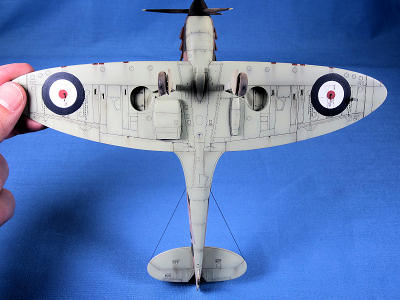 airbrushed coat of Testors Lacquer Flat Finish, sprayed
straight out of the bottle.
I
post-shaded the panel lines with a very dilute mix of 50/50 Tamiya XF1 Black and
Tamiya XF64 Red Brown, keeping it subtle as it’s an effect that is easy to
overdo.
Using this mix I also added
streaking for the machine guns and engine exhausts, as well as other areas on
the airframe.
airbrushed coat of Testors Lacquer Flat Finish, sprayed
straight out of the bottle.
I
post-shaded the panel lines with a very dilute mix of 50/50 Tamiya XF1 Black and
Tamiya XF64 Red Brown, keeping it subtle as it’s an effect that is easy to
overdo.
Using this mix I also added
streaking for the machine guns and engine exhausts, as well as other areas on
the airframe.
A couple of photos in my references show some
Mk. I’s with a lot of paint scuffing along the wing roots, especially on the
port side, so I tried to duplicate that effect using a Silver Berol pencil.
I sharpened the pencil and then gently jabbed it repeatedly onto the
surface, leaving lots of tiny silver dots.
The effect looks very good, but drives anyone nearby crazy as it sounds
like a woodpecker is attacking the house.
I painted the wingtip lights next.
They were first painted using Testors Chrome Silver, and then that was
followed by the applicable color of either Tamiya Clear Red or Clear Blue.
The final weathering effect was to dust the landing gear and tires with
some earth-colored pigments.
Finishing the model simply involved attaching the final fragile bits –
canopy, pitot tube, landing gear, etc.
I used stretched sprue for the antenna cables.
I painted them dark gray, and declared the model finished.
A nice, easy build.
I love
1/48 scale fighters.
| CONCLUSIONS |
| REFERENCES |
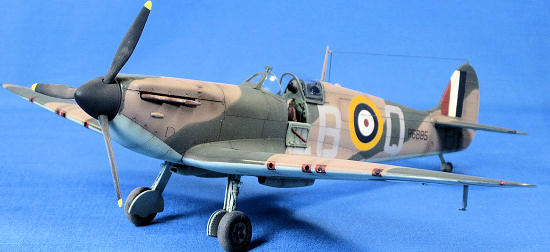 -
Osprey Publications, Aircraft of the Aces #12,
“Spitfire Mark I/II
Aces 1939-41”
-
Osprey Publications, Aircraft of the Aces #12,
“Spitfire Mark I/II
Aces 1939-41”
-
Specialty Press, Warbird Tech Series #35, “Merlin-Powered Spitfires”
- Squadron/Signal Publications, Aircraft in Action #39, “Spitfire in Action”
July 2012
Copyright ModelingMadness.com. All rights reserved. No reproduction in any form without express permission from the editor. If you would like your product reviewed fairly and fairly quickly, please contact the editor or see other details in the
Note to
Contributors.
Back to the Review
Index Page 2025